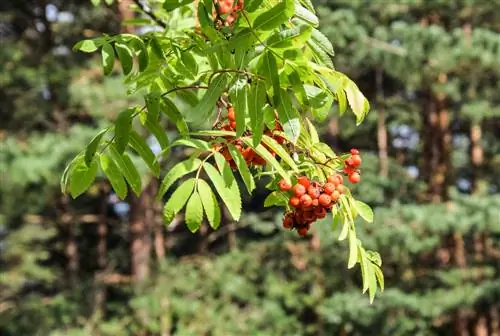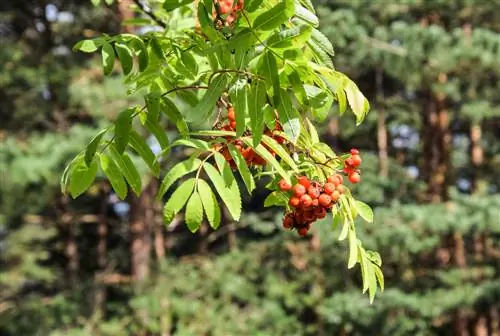- Author admin [email protected].
- Public 2023-12-16 16:46.
- Last modified 2025-01-23 11:21.
You are probably familiar with the ash tree as a deciduous tree. It is easy to assume that the mountain ash is a subspecies of the plant. But once again you shouldn't trust the name, because ash and mountain ash are two completely different genera of plants that are not related to each other. Find out what the differences are here.

What is the difference between ash and mountain ash?
The main difference between ash and rowan lies in their genus: ash is an olive tree family, while rowan is a member of the rose family. Other differences include height, age, leaf size and color, as well as the type of fruit they bear.
Characteristics of the ash tree
- belongs to the olive tree family
- one of the tallest deciduous trees in Europe (reaches a height of up to 40 m)
- spherical crown
- lives up to 300 years
- prefers deep, moist soils
- bears pinnate leaves
- Leaf color is very dark
- Leaves are about 20 to 30 cm long
- hard, yet flexible wood
- forms nuts with wings
- the fruits are about 2-3 cm long
Characteristics of rowan tree
- belongs to the rose family
- also called rowanberry
- carries small, pinnate leaves with a rounded shape
- Leaves are about 15 cm long
- bears red berries that are eaten by birds
- light crown
- maximum height is 25 m
- also occurs as a shrub
- lives up to 150 years
Just from the list you will certainly recognize many differences between ash and mountain ash. The most striking thing is probably the membership of the different genera. This results in differentiated characteristics such as fruits, height or age. Now the mountain ash is usually also referred to as false ash. But where does the name actually come from when the two trees have absolutely nothing to do with each other?
Name origin
Due rowan is called ash because of its leaves. These are visually similar because both have the same unpaired feathering. If you look closely, you will quickly be able to distinguish the leaves of the ash tree from those of its namesake: they are darker and larger.






